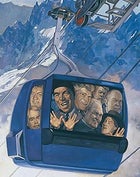BEFORE THERE WERE MEGARESORTS, there were passionate ski pioneers erecting rope tows and gondolas on untamed mountains from Maine to California. Love ’em or hate ’em (or both at once), these eight once-and-future piste-makers forever left their mark on North American skiing.
The Big Idea
Get the behind the gear and technology of the 21st century. Clockwise from bottom left: Hugh Smyth, Al Raine, Pete Seibert, Preston Leete Smith, Alex Cushing, Mike Shirley, Aaron Brill, and Dave McCoy.
Clockwise from bottom left: Hugh Smyth, Al Raine, Pete Seibert, Preston Leete Smith, Alex Cushing, Mike Shirley, Aaron Brill, and Dave McCoy.
Alex Cushing, 88, came to skiing as a Wall Street lawyer with a pile of money behind him. In 1948, he partnered with frustrated Squaw Valley developer Wayne Poulson and, with $400,000, built at a furious rate. His two-fisted approach resulted in a world-famous resort that attracted the 1960 Winter Olympics.
Now 87, Dave McCoy has been skiing since high school. In 1941 he set up a portable rope tow—a Model A Ford and a couple hundred feet of line, which he sold his Harley to pay for—on central California’s Mammoth Mountain, which officially opened in 1953.
A visionary 25-year-old who raised $85,000 to open Vermont’s Killington in 1958, Preston Leete Smith, now 72, was one of the first Eastern managers to see the crowd-pleasing value of snowmaking in an area that could suffer seasonlong droughts.
Before 10th Mountain Division veteran Pete Seibert, 77, opened Vail in 1962, most ski areas sprung up around existing towns. But Seibert knew that quality skiing—like gold—would attract a village. By the seventies, Vail was Ski Town U.S.A.
Al Raine, 60, spearheaded British Columbia’s ski movement in the seventies. A major player in the development of Sun Peaks and other resorts, he’s now drafting a controversial plan for a resort on Cayoosh Mountain, a pristine summit with thousands of acres of ski terrain—and mountain-goat, grizzly, and wolverine populations.
Skiing went corporate in the eighties, and Intrawest is the sport’s Microsoft. The current VP is Hugh Smythe, 54, an ex-patroller who rescued Alberta’s Fortress Mountain from bankruptcy in 1975. The company is known for reinventing struggling resorts; among its holdings are Whistler Blackcomb, Stratton, and Copper Mountain.
The father of the cheap season pass, Mike Shirley, 60, is a finance guy who was hired as the general manager at Idaho’s Bogus Basin in 1991. Slashing prices from $550 to $199, he boosted pass sales from 2,900 to 25,000 in one year and doubled revenues. More than 70 resorts have since followed suit.
Aaron Brill, the 30-year-old founder of Silverton Mountain—a one-lift ski area in Silverton, Colorado—is a throwback to the early days. His dream? Lift-served backcountry skiing based on the La Grave, France, model—no cut trails or infrastructure that isn’t dedicated to pure pow.


